Jessybrown
On this page, you find all documents, package deals, and flashcards offered by seller jessybrown.
- 2350
- 0
- 36
Community
- Followers
- Following
2386 items

BLS Recertification course exam
Agonal gasps are not normal breathing and may be present in the first minutes after sudden cardiac arrest - True The jaw thrust maneuver should be used to open the airway of an individual with suspected head or neck injury - True If you did not witness the arrest of a child or an infant you should provide two minutes of CPR before leaving them to activate the emergency response system and get the AED - True If you cannot see the infants chest rise and fall re-position the airway and attemp...
- Package deal
- Exam (elaborations)
- • 3 pages •
Agonal gasps are not normal breathing and may be present in the first minutes after sudden cardiac arrest - True The jaw thrust maneuver should be used to open the airway of an individual with suspected head or neck injury - True If you did not witness the arrest of a child or an infant you should provide two minutes of CPR before leaving them to activate the emergency response system and get the AED - True If you cannot see the infants chest rise and fall re-position the airway and attemp...
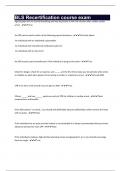
BLS Recertification course exam
Agonal gasps are not normal breathing and may be present in the first minutes after sudden cardiac arrest - True An AED can be used in which of the following special situations - All of the above An individual with an implanted a pacemaker An individual with transdermal medication patch on An individual with a hairy chest An AED may be used normally even if the individual is lying on the snow - True Check for danger, check for a response, and _____ are the first three steps you should tak...
- Package deal
- Exam (elaborations)
- • 3 pages •
Agonal gasps are not normal breathing and may be present in the first minutes after sudden cardiac arrest - True An AED can be used in which of the following special situations - All of the above An individual with an implanted a pacemaker An individual with transdermal medication patch on An individual with a hairy chest An AED may be used normally even if the individual is lying on the snow - True Check for danger, check for a response, and _____ are the first three steps you should tak...
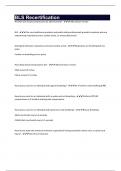
BLS Recertification
At what rate should compressions be administered? - 100-120 per minute BLS - the care healthcare providers and public safety professionals provide to patients who are experiencing respiratory arrest, cardiac arrest, or airway obstruction Distinguish between respiratory arrest and cardiac arrest - Respiratory-no breathing but has pulse Cardiac-no breathing and no pulse How deep should compressions be? - Adult-at least 2 inches Child-around 2 inches Infant-around 1.5 inches How do you car...
- Package deal
- Exam (elaborations)
- • 5 pages •
At what rate should compressions be administered? - 100-120 per minute BLS - the care healthcare providers and public safety professionals provide to patients who are experiencing respiratory arrest, cardiac arrest, or airway obstruction Distinguish between respiratory arrest and cardiac arrest - Respiratory-no breathing but has pulse Cardiac-no breathing and no pulse How deep should compressions be? - Adult-at least 2 inches Child-around 2 inches Infant-around 1.5 inches How do you car...
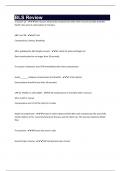
BLS Review
2 rescuer cpr - One rescuer will provide compressions while other rescuer provides breathes. Switch riles every 5 cycles (about 2 minutes) ABC's of CPR - C-A-B Compressions, Airway, Breathing After grabbing the AED (single rescuer) - -check for pulse and begin cpr (feel carotid pulse for no longer than 10 seconds) if no pulse is detected, start CPR immediately with chest compressions Avoid _______ between compressions and breaths - -Interruptions (interruptions should be less than 10 se...
- Package deal
- Exam (elaborations)
- • 3 pages •
2 rescuer cpr - One rescuer will provide compressions while other rescuer provides breathes. Switch riles every 5 cycles (about 2 minutes) ABC's of CPR - C-A-B Compressions, Airway, Breathing After grabbing the AED (single rescuer) - -check for pulse and begin cpr (feel carotid pulse for no longer than 10 seconds) if no pulse is detected, start CPR immediately with chest compressions Avoid _______ between compressions and breaths - -Interruptions (interruptions should be less than 10 se...
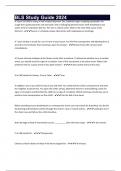
BLS Study Guide 2024
A 3 year old child is eating in the hospital playroom. She suddenly begins coughing repeatedly. Her cough then quickly becomes soft and weak. She is making hig-pitched noises while breathing in and seems to be in respiratory distress. Her skin is a bluish color. What is the most likely cause of her distress? - Severe or complete airway obstruction with inadequate air exchange. A 7 year old boy is struck by a car in front of your house. You find him unresponsive and bleeding from a wound on ...
- Package deal
- Exam (elaborations)
- • 7 pages •
A 3 year old child is eating in the hospital playroom. She suddenly begins coughing repeatedly. Her cough then quickly becomes soft and weak. She is making hig-pitched noises while breathing in and seems to be in respiratory distress. Her skin is a bluish color. What is the most likely cause of her distress? - Severe or complete airway obstruction with inadequate air exchange. A 7 year old boy is struck by a car in front of your house. You find him unresponsive and bleeding from a wound on ...
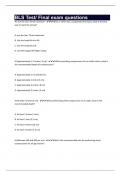
BLS Test/ Final exam questions
A ) Use the Jaw- thrust maneuver - When a victim has a suspected neck injury, what is the best way to open the airway? A. use the Jaw- Thrust maneuver B. Use the head tilt-chin lift C. Use the head tilt only D. Use the tongue lift-finger sweep A) Approximately 1.5 inches ( 4 cm) - When providing compressions for an infant victim, what is the recommended depth of compressions? A. Approximately 1.5 inches(4 cm) B. Approximately 1 inch (2.5 cm) C. Approximately 3 inches ( 8 cm) D. Approx...
- Package deal
- Exam (elaborations)
- • 7 pages •
A ) Use the Jaw- thrust maneuver - When a victim has a suspected neck injury, what is the best way to open the airway? A. use the Jaw- Thrust maneuver B. Use the head tilt-chin lift C. Use the head tilt only D. Use the tongue lift-finger sweep A) Approximately 1.5 inches ( 4 cm) - When providing compressions for an infant victim, what is the recommended depth of compressions? A. Approximately 1.5 inches(4 cm) B. Approximately 1 inch (2.5 cm) C. Approximately 3 inches ( 8 cm) D. Approx...
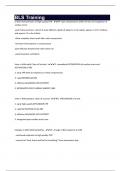
BLS Training
critical characteristics of high-quality CPR - -start compressions within 10 secs of recognition of cardiac arrest -push hard, push fast. rate of at least 100/min, depth of atleast 2 in for adults, approx 2 in for children, and approx 1.5 in for infants -allow complete chest recoil after each compression -minimize interruptions in compressions -give effective breaths that make chest rise -avoid excessive ventilation Links in AHA adult Chain of Survival - 1. immediate RECOGNITION of cardi...
- Package deal
- Exam (elaborations)
- • 4 pages •
critical characteristics of high-quality CPR - -start compressions within 10 secs of recognition of cardiac arrest -push hard, push fast. rate of at least 100/min, depth of atleast 2 in for adults, approx 2 in for children, and approx 1.5 in for infants -allow complete chest recoil after each compression -minimize interruptions in compressions -give effective breaths that make chest rise -avoid excessive ventilation Links in AHA adult Chain of Survival - 1. immediate RECOGNITION of cardi...
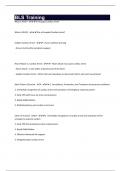
BLS Training Already Passed
What is IHCA? - In-Hospital Cardiac Arrest What is OHCA? - Out-of-hospital Cardiac Arrest? Sudden Cardiac Arrest - - Occurs without warning - Occurs shortly after symptoms appear - Heart Attack vs. Cardiac Arrest - - Heart attack may cause cardiac arrest - Heart attack = a clot within a blood vessel of the heart - Sudden Cardiac Arrest = When the heart develops an abnormal rhythm and can't pump blood Adult Chain of Survival - IHCA - 1. Surveillance, Prevention, and Treatment of prearres...
- Package deal
- Exam (elaborations)
- • 3 pages •
What is IHCA? - In-Hospital Cardiac Arrest What is OHCA? - Out-of-hospital Cardiac Arrest? Sudden Cardiac Arrest - - Occurs without warning - Occurs shortly after symptoms appear - Heart Attack vs. Cardiac Arrest - - Heart attack may cause cardiac arrest - Heart attack = a clot within a blood vessel of the heart - Sudden Cardiac Arrest = When the heart develops an abnormal rhythm and can't pump blood Adult Chain of Survival - IHCA - 1. Surveillance, Prevention, and Treatment of prearres...

BLS Training
2- Rescuer infant BLS sequence - 1. check for response and breathing 2. if no response and no breathing/only gasping, send second rescuer to active ERS and get AED 3. check brachial pulse 4. if no pulse, HR <60/min, perform cycles of compressions and breaths at 30:2 ratio until second rescuer arrives, then switch to 15:2 5. use AED as soon as it arrives Basic Steps of CPR for adults - 1) unresponsive, no breathing or no normal breathing -> activate ERS -> get AED -> check puls...
- Package deal
- Exam (elaborations)
- • 4 pages •
2- Rescuer infant BLS sequence - 1. check for response and breathing 2. if no response and no breathing/only gasping, send second rescuer to active ERS and get AED 3. check brachial pulse 4. if no pulse, HR <60/min, perform cycles of compressions and breaths at 30:2 ratio until second rescuer arrives, then switch to 15:2 5. use AED as soon as it arrives Basic Steps of CPR for adults - 1) unresponsive, no breathing or no normal breathing -> activate ERS -> get AED -> check puls...

BLS Worksheet RATED A+
Chest compressions are more often too shallow than too deep. -True Chest compressions depth greater than 2.4 inches in adults may cause injuries. -True Sudden cardiac arrest occurs when blood flow to the part of the heart muscle is blocked. -False A heart attack occurs when the heart develops an abnormal rhythm and can't pump blood. -False To check for breathing, scan the victim's chest for rise and fall for no more than 10 seconds. -True To perform a pulse check in an adult, palpate a ca...
- Package deal
- Exam (elaborations)
- • 10 pages •
Chest compressions are more often too shallow than too deep. -True Chest compressions depth greater than 2.4 inches in adults may cause injuries. -True Sudden cardiac arrest occurs when blood flow to the part of the heart muscle is blocked. -False A heart attack occurs when the heart develops an abnormal rhythm and can't pump blood. -False To check for breathing, scan the victim's chest for rise and fall for no more than 10 seconds. -True To perform a pulse check in an adult, palpate a ca...
